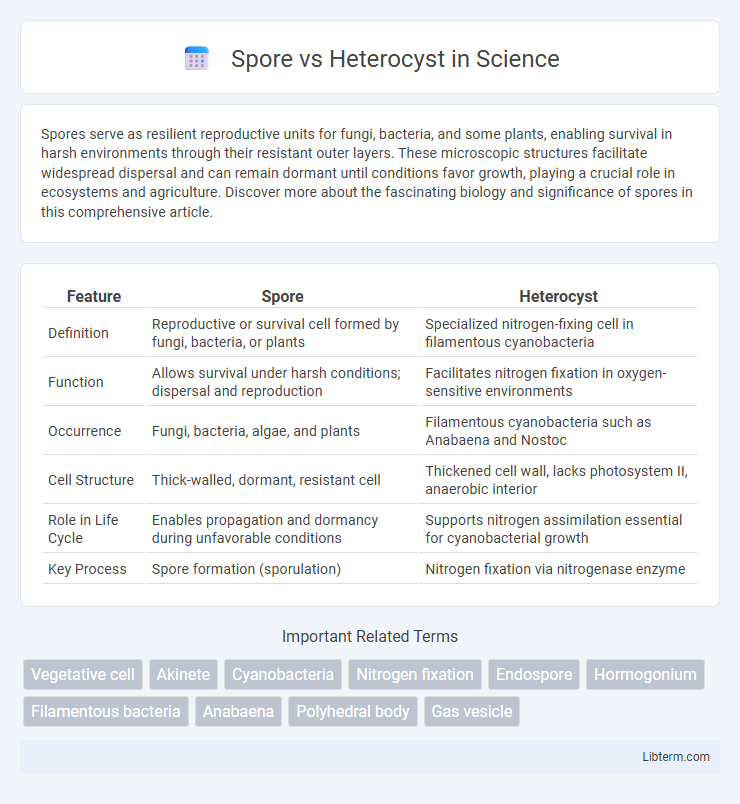Spores serve as resilient reproductive units for fungi, bacteria, and some plants, enabling survival in harsh environments through their resistant outer layers. These microscopic structures facilitate widespread dispersal and can remain dormant until conditions favor growth, playing a crucial role in ecosystems and agriculture. Discover more about the fascinating biology and significance of spores in this comprehensive article.
Table of Comparison
| Feature | Spore | Heterocyst |
|---|---|---|
| Definition | Reproductive or survival cell formed by fungi, bacteria, or plants | Specialized nitrogen-fixing cell in filamentous cyanobacteria |
| Function | Allows survival under harsh conditions; dispersal and reproduction | Facilitates nitrogen fixation in oxygen-sensitive environments |
| Occurrence | Fungi, bacteria, algae, and plants | Filamentous cyanobacteria such as Anabaena and Nostoc |
| Cell Structure | Thick-walled, dormant, resistant cell | Thickened cell wall, lacks photosystem II, anaerobic interior |
| Role in Life Cycle | Enables propagation and dormancy during unfavorable conditions | Supports nitrogen assimilation essential for cyanobacterial growth |
| Key Process | Spore formation (sporulation) | Nitrogen fixation via nitrogenase enzyme |
Introduction to Spore and Heterocyst
Spores are dormant, resilient structures formed by bacteria, fungi, and plants to survive unfavorable conditions, characterized by their ability to germinate into a new organism. Heterocysts are specialized nitrogen-fixing cells found in certain filamentous cyanobacteria, enabling survival in nitrogen-depleted environments by converting atmospheric nitrogen into ammonia. Both spores and heterocysts represent adaptive strategies, yet spores focus on persistence and dispersal, while heterocysts facilitate metabolic function under nutrient limitations.
Definition of Spore
A spore is a reproductive structure produced by bacteria, fungi, and plants, designed for survival under unfavorable conditions through dormancy and resistance to environmental stresses. Unlike heterocysts, which are specialized nitrogen-fixing cells found in certain filamentous cyanobacteria, spores function primarily for dispersal and propagation. Spores vary in morphology and formation mechanisms, enabling species-specific adaptation and genetic continuity.
Definition of Heterocyst
A heterocyst is a specialized nitrogen-fixing cell formed by certain filamentous cyanobacteria under nitrogen-deficient conditions, enabling the conversion of atmospheric nitrogen into ammonia for cellular use. Unlike spores, which serve as dormant and resistant reproductive structures for survival under harsh conditions, heterocysts actively facilitate metabolic processes critical for growth and nitrogen assimilation. This differentiation allows cyanobacteria to thrive in environments with limited nitrogen availability while maintaining photosynthetic activity in adjacent cells.
Structural Differences Between Spore and Heterocyst
Spores possess a thick, multi-layered protective coat made of keratin or chitin that ensures durability and resistance to extreme environmental conditions, whereas heterocysts feature a specialized glycolipid envelope limiting oxygen diffusion to facilitate nitrogen fixation. Structurally, spores are dormant, unicellular, and designed for reproduction and survival, while heterocysts are enlarged, nitrogen-fixing cells differentiated from vegetative cells in filamentous cyanobacteria with altered internal thylakoid arrangements. The presence of nitrogenase enzyme within heterocysts requires an anaerobic environment, which is structurally supported by the heterocyst's thickened cell wall and absence of photosystem II activity, contrasting with the inert, metabolically inactive nature of spores.
Formation Processes of Spore and Heterocyst
Spore formation involves a complex process of cellular differentiation where a vegetative cell undergoes multiple stages including DNA replication, cortex and coat development, and metabolic dormancy to form a highly resistant spore. In contrast, heterocyst formation in cyanobacteria is triggered by nitrogen deprivation, leading to the differentiation of vegetative cells into specialized nitrogen-fixing cells with thickened cell walls and altered metabolism to create a micro-oxic environment. These distinct formation processes highlight the adaptive strategies bacteria employ to survive unfavorable conditions and optimize nitrogen fixation.
Functional Roles in Microorganisms
Spores serve as resilient reproductive units in microorganisms, enabling survival under adverse environmental conditions by entering a dormant state and facilitating dispersal. Heterocysts, specialized nitrogen-fixing cells found in certain cyanobacteria, play a crucial role in converting atmospheric nitrogen into ammonia, supporting growth in nitrogen-poor environments. While spores primarily ensure species propagation and endurance, heterocysts contribute to metabolic function and ecological nitrogen cycling.
Environmental Adaptation and Survival Mechanisms
Spores enable microorganisms like fungi and bacteria to survive extreme environmental conditions through dormancy and resistance to heat, desiccation, and chemicals. Heterocysts, specialized nitrogen-fixing cells in certain cyanobacteria, adapt to oxygen-sensitive nitrogen fixation by creating a low-oxygen microenvironment, ensuring survival in nitrogen-poor habitats. Both structures represent evolutionary strategies for sustaining life, with spores primarily focused on dormant endurance and heterocysts on metabolic adaptation to nutrient limitation.
Occurrence in Different Organisms
Spores occur predominantly in fungi, bacteria, algae, and non-seed plants such as ferns, serving as reproductive or survival units. Heterocysts are specialized nitrogen-fixing cells found exclusively in certain filamentous cyanobacteria. While spores enable organisms to endure harsh environments and propagate, heterocysts facilitate nitrogen fixation under aerobic conditions.
Significance in Biotechnology and Ecology
Spores serve as resilient reproductive units in biotechnology, enabling the development of durable probiotics and biofertilizers, while heterocysts are specialized nitrogen-fixing cells critical for sustainable agriculture through cyanobacterial inoculants. In ecology, spores contribute to species propagation and genetic diversity across harsh environments, whereas heterocysts play a vital role in nitrogen cycling, enhancing soil fertility and supporting aquatic ecosystems. Both structures exemplify adaptive strategies that underpin ecosystem stability and biotechnological innovations.
Key Differences: Spore vs Heterocyst
Spores are reproductive structures formed by fungi, algae, and some plants to ensure survival under adverse conditions, characterized by their ability to germinate into a new organism. Heterocysts are specialized nitrogen-fixing cells found in certain filamentous cyanobacteria, enabling the conversion of atmospheric nitrogen into ammonia under anaerobic conditions. Key differences include spores serving primarily for reproduction and dispersal, while heterocysts function in nitrogen fixation within the organism.
Spore Infographic

 libterm.com
libterm.com